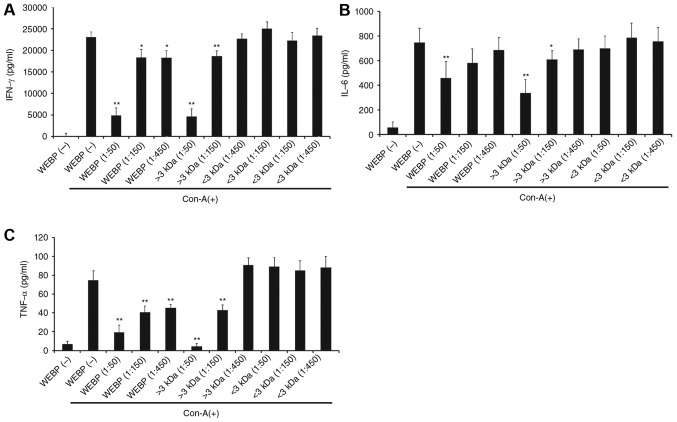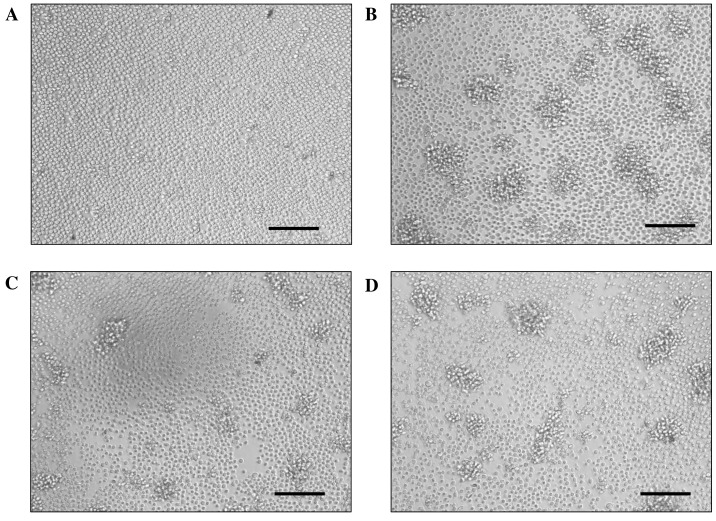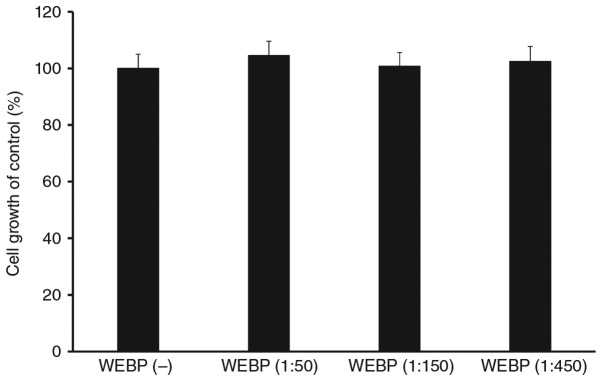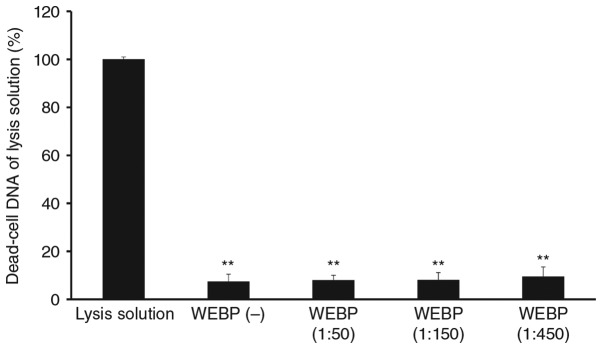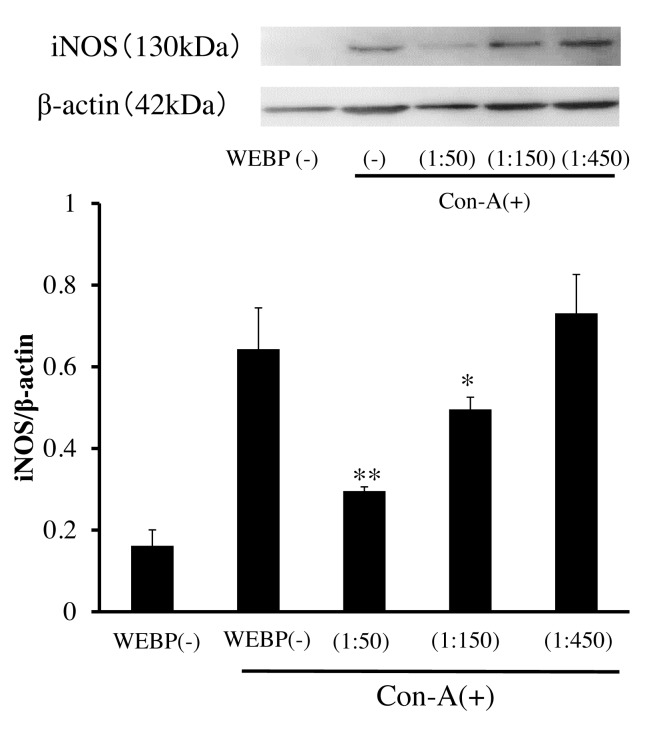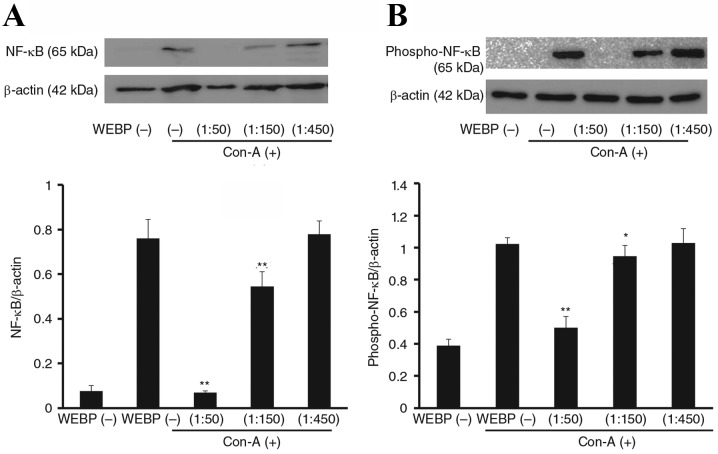Abstract
Fruits and vegetables have been recognized as natural sources of various bioactive compounds. Peppers, one such natural source, are consumed worldwide as spice crops. They additionally have an important role in traditional medicine, as a result of their antioxidant bioactivity via radical scavenging. However, there are no reports regarding the bioactivity of the bell pepper (Capsicum annuum L. var. grossum), a commonly used edible vegetable. The present study aimed to evaluate the anti-inflammatory effect of water extract from bell pepper leaves on mouse spleen cells, and explore the potential mechanism underlying this effect. The extract was prepared through homogenization of bell pepper leaves in deionized water. The sterilized supernatant was added to a mouse spleen cell culture stimulated by concanavalin A. Following 72 h of culture, the levels of inflammatory cytokines in the culture supernatant were measured using a sandwich enzyme-linked immunosorbent assay system, and levels of inflammatory proteins were assessed using western blotting. The bell pepper leaf extract significantly inhibited inflammatory cytokine production, inhibited cell proliferation without producing cytotoxicity, and suppressed the expression of inflammatory proteins. These results suggest that components of the bell pepper leaf extract possess anti-inflammatory activity. The study of the anti-inflammatory mechanism of bell pepper leaf extract has provided useful information on its potential for therapeutic application.
Keywords: bell pepper, inflammatory, natural product, cytokines, mouse spleen cell
Introduction
Immunosuppressive drugs are used for the treatment of undesirable or abnormal activation of T lymphocytes and the immune system associated with organ transplantation and autoimmune diseases. T lymphocytes play a pivotal role in the pathogenesis of cell-mediated autoimmune diseases and chronic inflammatory disorders (1–3). Activation of T lymphocytes requires stimulation of T-cell receptors and costimulatory signals. Ca2+ influx is crucial for T-cell activation upon antigen stimulation (4). The best known costimulatory signals are those of NF-κB (nuclear factor kappa-light-chain-enhancer of activated B cells). NF-κB is activated by Ca2+/calmodulin dependent protein kinase (CaMK II) (5,6). NF-κB translocates to the nucleus and turns on transcription of specific genes, generally related to inflammatory or immune responses, cell survival responses, or cell proliferation.
Recently, fruits and vegetables have been recognized as natural sources of various bioactive compounds (7–9). Natural antioxidants often exist together in different combinations in nature, and consequently researchers have been investigating the additive and synergistic effects of different antioxidants (10,11).
One such vegetable where a variety of antioxidants can be found is the pepper. The pepper belongs to the genus Capsicum, which contains >200 varieties, with Capsicum annuum, Capsicum baccatum, Capsicum chinense, Capsicum frutescens, and Capsicum pubescens being the main five species (12,13). Peppers are consumed worldwide and their importance has gradually increased to place them among the most consumed spice crops in the world (14). They also have a significant role in traditional medicine (15,16). It has been reported that the red pepper fruit of Capsicum baccatum shows anti-inflammatory activity via nitric oxide scavenging activity (17). These findings indicate that the bell pepper has a potential immunosuppressive function through its effects on cells. However, the anti-inflammatory and underlying immunosuppressive mechanisms of the bell pepper (Capsicum annuum L. var. grossum), one of the species of the genus Capsicum, are still largely unknown and require further investigation. In this study, we investigated the in vitro anti-inflammatory effect of water extract from bell pepper leaves (WEBP) on mouse spleen cells, and explored the potential mechanism underlying this effect. We found that WEBP significantly inhibited Con-A-stimulated spleen cell proliferation, cytokine production, and expression of inflammatory proteins. The data also showed that WEBP exhibited an immunosuppressive effect, via inhibition of T-cell activation through the NF-κB pathway.
The results indicate that some bioactive components are present in WEBP, which can exert anti-inflammatory and immunosuppressive effects. The study of the anti-inflammatory mechanism of WEBP has provided some useful information on its potential for therapeutic application.
Materials and methods
Animals
ICR mice (male, 5 weeks of age) weighing 18–22 g were purchased from the Kyudo Laboratory Animal Center Co., Ltd., (Fukuoka, Japan) and were housed in polypropylene cages with sawdust bedding. The temperature was maintained at 24±1°C, with humidity of 50±10% and a 12 h light/dark cycle. Food and water were available ad libitum. The procedures used for the animals and their care followed the internationally accepted Guidelines for Keeping Experimental Animals, issued by the Government of Japan. The researchers received ethical training from the Fukuoka University Ethics Committee.
Preparation of water extract from bell pepper (Capsicum annuum L. var. grossum) leaves
WEBP was obtained as follows. Bell pepper (Capsicum annuum L. var. grossum) leaves were collected in Fukuoka at harvest just before. This bell pepper's seed was purchased from TAKII SEED CO., LTD (Kyoto, Japan). A total of 5 g of wet bell pepper leaves were cut finely with scissors. Bell pepper leaves were stored at −80°C in vacuum storage before use. The leaves cut finely were homogenized, and were extracted using a closed tissue grinder (Kimble Chase, Vineland, NJ, USA) in 5 ml of deionized water. The obtained extract was centrifuged (3,000 × g, 25°C, 10 min). The supernatant of the extract was used in this study as WEBP group. The fraction including components over 3 kDa was separated as >3 kDa group by ultrafiltration (Ultracel® YM-3, Merck Millipore Ltd, Darmstadt, Germany) from the original extract (WEBP). Meanwhile, the fraction including components below 3 kDa was used as <3 kDa group. WEBP and its fractions were used as diluted to 50, 150 and 450 times in the water.
Chromatographic conditions
WEBP and its fractions were analyzed by using a 150×4.6 mm reversed-phase C18 5-µm column (CAPCELLPACK C18 UG120, SHISEIDO Co. Ltd., Tokyo, Japan) maintained at a constant temperature (30°C). The mobile phase was acetonitrile-water (70: 30) with a flow rate of 1 ml/min, and the detection wavelength was at 280 nm. The sample injection was 5 µl. The Agilent 1220 Infinity LC System (Agilent Technologies, Tokyo, Japan) was used as HPLC system.
Spleen cell culture
Spleen cells were prepared as described in a previous study (18,19). Briefly, the spleen was removed from the mice, placed in phosphate buffered saline (PBS), minced, and passed through a nylon mesh to yield a homogeneous cell suspension. After 10 min of centrifugation at 400 × g at 4°C, the cell pellets were washed twice with PBS and resuspended in RPMI 1640 medium containing 10% heat-inactivated fetal calf serum (FCS). The spleen cells were seeded in a 96-well flat-bottom plate (Nunc) at a concentration of 5.0×106 cells/ml. Subsequently, Con-A (5 µg/ml) and WEBP, or 3 kDa fraction in medium was added to provide a final volume of 200 µl. Plates were incubated for 72 h at 37°C in a humidified atmosphere with 5% CO2. The supernatants of this each well were used ELISA to measure the level of cytokine.
Meanwhile, the cell survival/proliferetaion of WEBP under non Con-A stimulation in mouse spleen cells was assessed using the WST-8 assay kit (Nacalai Tesque Inc., Kyoto, Japan), according to the manual. WST-8 reagents (2-(2-methpxy-4-nitrophenyl)-3-(4-nitrophenyl)-5-(2,4-disulfophenyl)-2H-tetrazolium, monosodium salt) were added to the culture. After 3 h of incubation, the absorbance was determined at 450 nm using a microplate reader.
Furthermore, the cytotoxicity of WEBP under non Con-A stimulation in mouse spleen cells was assessed by analyzing the membrane integrity, using a CellTox Green kit, according to the manual (Promega Corporation, Madison, WI, USA).
Measurement of cytokines using enzyme-linked immunosorbent assay (ELISA)
Cytokine levels in the collected sterilized supernatants of the Con-A-stimulated mouse spleen cell cultures at 72 h were measured using ELISA. Briefly, 96 well plates were coated with monoclonal antibodies [0.5 µg/ml anti-mouse interferon-γ (IFN-γ), purified; 1.0 µg/ml anti-mouse interleukin 6 (IL-6), purified; and 2.0 µg/ml anti-mouse tumor necrosis factor α (TNF-α), purified] overnight at 4°C and washed with PBS. Blocking One solution (Nacalai Tesque, Inc.) was diluted 5-fold with Tris buffered saline containing 0.05 (v/v) % Tween-20 (TBST) and 250 µl/well of blocking solution were added to the plates. After 1 h of incubation at room temperature (RT), the collected sterilized supernatants of Con-A-stimulated mouse spleen cell cultures were added to the plates in a 1:10 dilution in RPMI medium containing 10% FCS. The plates were further incubated for 1 h at RT and then washed with PBS. Biotinylated antibodies (1.0 µg/ml biotinylated anti-mouse IFN-γ; 1.0 µg/ml biotinylated anti-mouse IL-6; and 0.8 µg/ml biotinylated anti-mouse TNF-α) were added and the plates were incubated for 1 h at RT. Streptavidin horseradish peroxidase (SNN 1004; Biosource International, Inc., Camarillo, CA, USA; 1:10,000) was then added and the plates were incubated for 1 h at RT. After the plates had been washed with TBST thoroughly, 100 µl of peroxidase substrate solution consisting of equal volumes of 3,3′,5,5′-tetramethylbenzidine (TMB) peroxidase substrate and peroxidase substrate solution B (TMB Microwell Peroxidase Substrate System; KPL Inc., Gaithersburg, MD, USA) was added to each well and incubated for 10 min, followed by an equal volume of stop solution. Absorbance was measured at 450 nm with an ELISA reader (Bio-Rad Model 680 Microplate Reader; Bio-Rad, Hercules, CA, USA). All anti-cytokine antibodies were purchased from eBioscience (San Diego, CA, USA).
Immunoblot analysis
For the detection of inflammatory proteins, the cells were lysed in a lysis buffer. The total protein concentration was measured using a BCA assay (Pierce Biotechnology, Rockford, IL, USA). Each cell lysate (containing equal amounts of protein) was subjected to SDS-PAGE (Bio-Rad) and the proteins were then transferred onto polyvinylidene difluoride membranes (Bio-Rad). The membranes were blocked with Blocking One (Nacalai Tesque, Inc.) overnight at 4°C, and were then incubated for 1 h at RT with an anti-iNOS (induced nitric oxide synthase) antibody, an anti-NF-κB antibody, an anti-phosphorylated NF-κB antibody (Cell Signaling Technology Inc., Beverly, MA, USA), or an anti-β-actin antibody (Santa Cruz Biotechnology Inc., Santa Cruz, CA, USA) at a 1:500 dilution in blocking solution. After washing three times, the membranes were incubated for 1 h at RT with a secondary antibody (a horseradish peroxidase-conjugated species-specific antibody). Immunoreactive bands were visualized using ImmunoStar® LD (Wako Pure Chemical Industries Ltd., Osaka, Japan).
Statistical analysis
The results are expressed as mean ± SD (n=3-4). The data were evaluated for statistical significance using the Bonferroni test for differences between the groups. The overall significance was determined using a one-way ANOVA (repeated measures). P<0.05 was considered to indicate a statistically significant difference.
Results
HPLC chromatography
The one sharp peak of WEBP under 280 nm was appeared at 1.345 min as shown in Fig. 1A. The sharp peak of fraction (>3 kDa) was also appeared at 1.365 min as shown in Fig. 1B. Meanwhile, the peak of fraction (<3 kDa) were not shown in Fig. 1C.
Figure 1.
High-performance liquid chromatography chromatogram of WEBP and its fractions. (A) WEBP, (B) Fraction >3 kDa (C) Fraction <3 kDa. WEBP, water extract from bell pepper leaves.
Effect of WEBP on inflammatory cytokines
We used Con-A as a stimulus to promote cytokine secretion in mouse spleen cells. Then, the effects of WEBP on the production of the IFN-γ, IL-6, and TNF-α cytokines were examined.
The level of IFN-γ, IL-6, and TNF-α production increased in mouse spleen cells stimulated by Con-A. Meanwhile, this increased production was suppressed by the addition of WEBP (1:50, 1:150, 1:450 dilution of extract in water) as shown in Fig. 2A, B and C, respectively. The Con-A-stimulated increase in the level of IFN-γ, IL-6, and TNF-α production was also suppressed by the addition of the fraction containing extract component over 3 kDa (1:50, 1:150, 1:450 dilution of fraction in water) as shown in Fig. 2A, B and C, respectively. However, addition of the fraction containing extract components below 3 kDa produced no significant change in the level of IFN-γ, IL-6, and TNF-α production.
Figure 2.
Effect of WEBP on IFN-γ, IL-6 and TNF-α secretion in cell culture supernatant. The levels of the cytokine IFN-γ (A), IL-6 (B) and TNF-α (C) were analyzed after culturing mouse spleen cells in the presence of different concentrations of WEBP or fraction separated by 3 kDa ultrafiltration from WEBP and Con-A for 72 h. The IFN-γ, IL-6 and TNF-α levels were quantified by ELISA. The data are presented as mean ± SD (n=3). *P<0.05, **P<0.01 vs. Con-A (+)/WEBP (−) group (Bonferroni test/ANOVA). WEBP, water extract from bell pepper leaves; IFN-γ, anti-mouse interferon-γ; IL-6, anti-mouse interleukin 6; TNF-α, anti-mouse tumor necrosis factor α.
Cell clusters were induced in mouse spleen cell cultures stimulated by Con-A, as shown in Fig. 3. Cell clusters induced by Con-A mean activation of spleen cells but not proliferation. The number and size of the clusters were reduced by treatment with WEBP, in a dose-dependent manner, compared with the non-treatment group (Con-A (+)). These results indicate that WEBP strongly suppressed T-cell activation stimulated by Con-A.
Figure 3.
Microscopic images of Con-A-stimulated mouse spleen cell cultures. Representative images of spleen cells without and with Con-A are shown in (A and B), respectively. Representative images of spleen cells stimulated with Con-A treated with WEBP (1:50 and 1:150 dilution of extract in water) are shown in (C) and (D), respectively. Scale bar,100 µm. WEBP, water extract from bell pepper leaves.
Effect of WEBP on cell survival/proliferation
Spleen cells without Con-A were treated with different doses of WEBP (1:50, 1:150, 1:450 dilution of extract in water) and cell survival/proliferation were assessed using a WST-8 assay. As shown in Fig. 4, there was no significant differences in cell growth of control (%) between WEBP (−) and various concentration of WEBP treatment group.
Figure 4.
Effect of WEBP on mouse spleen cell viability and proliferation. The cells were treated with WEBP (1:50, 1:150, 1:450 dilution of extract in water) for 72 h. The cell viability was determined using a WST-8 assay. The data are presented as mean ± SD (n=3). WEBP, water extract from bell pepper leaves.
Cytotoxic activity of WEBP against Con-A stimulated mouse spleen cell cultures
Spleen cells without Con-A were treated with different doses of WEBP (1:50, 1:150, 1:450 dilution of extract in water) and cytotoxicity was assessed using the CellTox Green assay. There was no significant cytotoxicity produced by WEBP in mouse spleen cells after 72 h of incubation as shown in Fig. 5.
Figure 5.
Effect of WEBP on mouse spleen cell cytotoxicity. The cells were treated with WEBP (1:50, 1:150, 1:450 dilution of extract in water) for 72 h. The cytotoxicity was determined using a CellTox Green assay. The data are presented as mean ± SD (n=3). **P<0.01 vs. Lysis solution (Bonferroni test/ANOVA). WEBP, water extract from bell pepper leaves.
Inhibitory effect of WEBP on expression of inflammatory proteins (iNOS, NF-κB) in Con-A stimulated mouse spleen cells
To investigate the mechanism of WEBP, we examined its effect on the expression of inflammatory proteins, as assessed by western blotting. As shown in Fig. 6, expression levels of iNOS in mouse spleen cells stimulated by Con-A were significantly inhibited by WEBP in a dose-dependent manner. Furthermore, expression levels of NF-κB and phospho-NF-κB in mouse spleen cells stimulated by Con-A were also significantly inhibited by WEBP as shown in Fig. 7. The inhibition was detected 72 h after stimulation with Con-A in mouse spleen cell cultures treated with WEBP (1:50, 1:150, 1:450 dilution of extract in water).
Figure 6.
Effect of WEBP on iNOS expression levels in mouse spleen cells. Spleen cells were treated with WEBP and stimulated with Con-A for 72 h. A representative image of a western blot showing iNOS expression levels is shown. The data are presented as mean ± SD (n=3). *P<0.05, **P<0.01 vs. Con-A (+)/WEBP (−) group (Bonferroni test/ANOVA). WEBP, water extract from bell pepper leaves; iNOS, induced nitric oxide synthase.
Figure 7.
Effect of WEBP on NF-κB and phospho-NF-κB expression levels in mouse spleen cells. Spleen cells were treated with WEBP and stimulated with Con-A for 72 h. Representative images of western blots showing expression of (A) NF-κB and (B) phospho-NF-κB are shown. The data are presented as mean ± SD (n=3). *P<0.05, **P<0.01 vs. Con-A (+) / WEBP (−) group (Bonferroni test/ANOVA). NF-κB, nuclear factor kappa-light-chain-enhancer of activated B cells; WEBP, water extract from bell pepper leaves.
Discussion
Immunosuppressive agents are an important drug class that is valuable for the treatment of various human diseases, including autoimmune diseases. Although there are a variety of immunosuppressive drugs such as cyclosporine A, tacrolimus (FK506), methotrexate, azathioprine, and rituximab, their toxicity is a major obstacle to their widespread use (20–22). Therefore, new and safer immunosuppressive drugs against acute and chronic rejection of transplants, and for the treatment of other autoimmune diseases, are eagerly awaited. There has been an increasing interest in exploring phytochemicals with therapeutic potential in autoimmune disease, in that they can be purified, synthesized, and chemically modified to design new drugs and often have low toxicity. In this study, we report that WEBP has potent immunosuppressive activity in vitro.
The fraction (>3 kDa) with sharp peak in the HPLC chromatogram showed anti-inflammatory activity as shown in Fig. 2. Meanwhile, the fraction (<3 kDa) without peak did not show anti-inflammatory activity as shown in Fig. 2. Thus, there were correlation between existence of peak and anti-inflammatory activity. In the previous study, capsaicin included in other Capsicum plants has been known to show anti-inflammatory activity (23,24). In this study, we tried to measure of HPLC chromatogram of capsaicin in the same HPLC condition. The peak of capsaicin appeared at 6.400 min (data not shown). Furthermore, capsaicin did not suppress the level of IL-6 and expression level of NF-κB in spleen cell culture stimulated by Con-A. From these result, the active ingredient including WEBP was not capsaicin at least.
In Fig. 2, IFN-γ, IL-6 and TNF-α secretion after Con-A stimulation with WEBP treatment has shown a dose-dependent manner. Furthermore, IFN-γ levels treated with WEBP diluted at 1:50, 1:75 and 1:150 in water were determined to confirm about a concentration-response between 1:50 and 1:150. The IFN-γ levels treated with WEBP diluted at 1:50, 1:75 and 1:150 in water were 5,283±116 (mean ± SD), 12,223±238 and 18,870±326 pg/ml, respectively. IFN-γ levels were suppressed linearly by treatment with WEBP under 1:150 dilution.
Cytokines are important modulators and effectors in the immune system. In particular, multiple proinflammatory cytokines have been reported to be closely associated with many autoimmune diseases. It has been shown that Th1 cells produce IL-2, IFN-γ, IL-12, and other cytokines when stimulated; and Th2 cells produce IL-4, IL-5, IL-6, and IL-10 (25). Overactivation of either response could lead to Th1 or Th2 polarization. The imbalance of Th1/Th2 could lead to immunological diseases, such as rheumatoid arthritis, type-1 diabetes mellitus, and multiple sclerosis (26). In this study, we used Con-A as a activator of T-cell proliferation, and selected IFN-γ as a Th1 cytokine and IL-6 as a Th2 cytokine to test the effect of WEBP on modulating the levels of Th1 and Th2 cytokines. The results showed that WEBP could effectively rectify the Th1 and Th2 polarization in mouse T lymphocytes.
Inhibition of important components of the Ca2+ signaling pathway revealed that Con-A-induced NF-κB activation depends on a Ca2+/calmodulin/CaMK II pathway (27,28). It has been reported that daphnetin inhibited p-CaMK II and NF-κB activation in mouse spleen cell cultures stimulated by Con-A (29). To determine the influence of WEBP on NF-κB activation, expression of iNOS, NF-κB, and phospho-NF-κB were examined. The results showed that expression of iNOS, NF-κB, and phospho-NF-κB were significantly inhibited by treatment with WEBP. These results indicate that immunosuppressive components present in WEBP can exert an influence on the Ca2+ signaling pathway. Furthermore, the WEBP inhibited expression of both NF-κB and phospho-NF-κB to a similar degree, and the ratio of phosphorylated NF-κB to non-phosphorylated NF-κB was not significantly altered, indicating that WEBP likely had no direct effects on NF-κB phosphorylation.
In conclusion, our results demonstrated that the WEBP had anti-inflammatory activity, mediated as immunosuppressive activity against T-cell activation in vitro. The anti-inflammatory effects might be associated with NF-κB translocation. These findings extend our understanding of the immunomodulatory effects of WEBP and suggest that it has potential as a new and effective phytochemical compound for the treatment of T-cell-mediated immune diseases. Because WEBP produced no cytotoxicity in mouse spleen cells, our study suggests the possibility of using bioactive compounds present in WEBP as novel safe immunosuppressants. Furthermore, our results pertaining to the suppression of cytokine production suggest that these bioactive compounds possess a molecular weight of over 3 kDa.
In the present study, the molecular size of fraction was decided at 3 kDa, which is the lower limit in the column of FPLC or Gel filtration chromatography to purify the crude extract sample in the next step to identify the bioactive compounds. In general, the molecular weight of monomeric polyphenol or saponins might be below 3 kDa, the so-called low-molecular-weight compound. However, its molecular weight might be over 3 kDa when the monomer forms the multimetric compound. Furthermore, there is possibility that the bioactive compounds might be amino acid, peptide or protein because the peak was detected at 280 nm in the HPLC profile.
We are planning to prepare the further fraction using over 3 kDa extract by FPLC or Gel filtration chromatography or ultrafiltration. Furthermore, the bioactive compounds including further fraction will be separated by SDS-PAGE. The band derived for bioactive compounds will be identified by LC/MS/MS or N-terminal amino acid analysis. Finally, we are planning to determine its anti-inflammatory activity mechanism of bioactive compounds and further functional analysis.
Acknowledgements
The present study was supported by funds (gran no. 161045) from the Central Research Institute of Fukuoka University.
References
- 1.Abbas AK, Mulphy KM, Sher A. Functional diversity of helper T lymphocytes. Nature. 1996;383:787–793. doi: 10.1038/383787a0. [DOI] [PubMed] [Google Scholar]
- 2.Snell GI, Westall GP, Paraskeva MA. Immunosuppression and allograft rejection following lung transplantation: Evidence to date. Drugs. 2013;73:1793–1813. doi: 10.1007/s40265-013-0136-x. [DOI] [PubMed] [Google Scholar]
- 3.van Sandwijk MS, Bemelman FJ, Ten Berg IJ. Immunosupressive drugs after solid organ transplantation. Neth J Med. 2013;71:281–289. [PubMed] [Google Scholar]
- 4.Pecarce EL. Metabolism in T cell activation and differentiation. Curr Opin Immunol. 2010;22:314–320. doi: 10.1016/j.coi.2010.01.018. [DOI] [PMC free article] [PubMed] [Google Scholar]
- 5.Ma W, Mishra S, Gee K, Mishra JP, Nandan D, Reiner NE, Angel JB, Kumar A. Cyclosporin A and FK506 inhibit IL-12p40 production through the calmodulin/calmodulin-dependent protein kinase-activated phosphoinositide 3-kinase in lipopolysaccharide stimulated human monocytic cells. J Biol Chem. 2007;282:13351–13362. doi: 10.1074/jbc.M611522200. [DOI] [PubMed] [Google Scholar]
- 6.Hughes K, Edin S, Antonsson A, Grundström T. Calmodulin-dependent kinase II mediaters T cell receptor/CD3-and phorbol ester-induced activation of Ikappaβ kinase. J Biol Chem. 2001;276:36008–36013. doi: 10.1074/jbc.M106125200. [DOI] [PubMed] [Google Scholar]
- 7.Pennington JAT, Fisher RA. Food component profiles for fruit and vegetable subgroups. J Food Composition Analysis. 2010;23:411–418. doi: 10.1016/j.jfca.2010.01.008. [DOI] [Google Scholar]
- 8.Dembitsky VM, Poovarodom S, Leontowicz H, Leontowicz M, Vearasilp S, Trakhtenberg S, Gorinstein S. The multiple nutrition properties of some exotic fruits: Biological activity and active metabolites. Food Res Int. 2011;44:1671–1701. doi: 10.1016/j.foodres.2011.03.003. [DOI] [Google Scholar]
- 9.Ayala-Zavala JF, Vega-Vega V, Rosas-Domínguez C, Palafox-Carlos H, Villa-Rodriguez JA, Wasim Siddiqui Md, Dávila-Aviña JE, González-Aguilar GA. Agro-industrial potential of exotic fruit by products as a source of food additives. Food Res Int. 2011;44:1866–1874. doi: 10.1016/j.foodres.2011.02.021. [DOI] [Google Scholar]
- 10.Liu DH, Shi J, Ibarra AC, Kakuda Y, Xue SJ. The scavenging capacity and synergistic effects of lycopene, vitamin E, vitamin C, and β-carotene mixtures on the DPPH free radical. Food Sci Technol. 2008;41:1344–1349. [Google Scholar]
- 11.Müller L, Fröhlich K, Böhm V. Comparative antioxidant activities of carotenoids measured by ferric reducing antioxidant power (FRAP), ABTS bleaching assay (αTEAC), DPPH assay and peroxyl radical scavenging assay. Food Chem. 2011;129:139–148. doi: 10.1016/j.foodchem.2011.04.045. [DOI] [Google Scholar]
- 12.Zimmer AR, Leonardi B, Miron D, Schapoval E, Oliveira JR, Gosmann G. Antioxidant and anti-inflammatory properties of Capsicum baccatum: From traditional use to scientific approach. J Ethnopharmacol. 2012;139:228–233. doi: 10.1016/j.jep.2011.11.005. [DOI] [PubMed] [Google Scholar]
- 13.Menichini F, Tundis R, Bonesi M, Loizzo MR, Conforti F, Stattti G, Cindio BD, Houghton PJ, Menichini F. The influence of fruit ripening on the phytochemical content and biological activity of Capsicum chinense Jacq. cv Habanero. Food Chem. 2009;114:553–560. doi: 10.1016/j.foodchem.2008.09.086. [DOI] [Google Scholar]
- 14.Bown D. Encyclopedia of Herbs and Their Uses, Kindersley Dorling, London. Herb society of America; London, UK: 2001. [Google Scholar]
- 15.Meghvansi MK, Siddiqui S, Khan MH, Gupta VK, Vairale MG, Gogoi HK, Singh L. Naga chili: A potential source of capsaicinoids with broad-spectrum ethdopharmacological applications. J Ethnopharmacol. 2010;132:1–14. doi: 10.1016/j.jep.2010.08.034. [DOI] [PubMed] [Google Scholar]
- 16.Wyk BEV, Wink M. Medicinal Plants of the World: An Illustrated Scientific Guide to Important Medicinal Plants and Their Uses. Timber Press; Portland, Ore, USA: 2004. [Google Scholar]
- 17.Antonious GF, Kochhar TS, Jarret RL, Snyder JC. Antioxidants in hot pepper: Variation among accessions. J Environ Sci Health B. 2006;41:1237–1243. doi: 10.1080/03601230600857114. [DOI] [PubMed] [Google Scholar]
- 18.Song X, Bao S, Wu L, Hu S. Ginseng stem-leaf saponins (GSLS) and mineral oil act synergistically to enhance the immune responses to vaccination against foot-and-mouth disease in mice. Vaccine. 2009;27:51–55. doi: 10.1016/j.vaccine.2008.10.030. [DOI] [PubMed] [Google Scholar]
- 19.Xie F, Li Y, Su F, Hu S. Adjuvant effect of Atractylodis macrophalae Koidz. polysaccharides on the immune response to foot-and-mouth disease vaccine. Carbohydr Polym. 2012;87:1713–1719. doi: 10.1016/j.carbpol.2011.09.080. [DOI] [Google Scholar]
- 20.Strauss G, Osen W, Debatin KM. Induction of apoptosis and modulation of activation and effector function in T cells by immunosuppressive drugs. Clin Exp Immunol. 2002;128:255–266. doi: 10.1046/j.1365-2249.2002.01777.x. [DOI] [PMC free article] [PubMed] [Google Scholar]
- 21.Sakuma S, Kato Y, Nishigaki F, Magari K, Miyata S, Ohkubo Y, Goto T. Effects of FK506 and other immunosuppressive anti-rheumatic agents on T cell activation mediated IL-6 and IgM production in vitro. Int Immunopharmacol. 2001;1:749–757. doi: 10.1016/S1567-5769(01)00008-X. [DOI] [PubMed] [Google Scholar]
- 22.Sakuma S, Kato Y, Nishigaki F, Sasakawa T, Magari K, Miyata S, Ohkubo Y, Goto T. FK506 potently inhibits T cell activation induced TNF-alpha and IL-1beta production in vitro by human peripheral blood mononuclear cells. Br J Pharmacol. 2000;130:1655–1663. doi: 10.1038/sj.bjp.0703472. [DOI] [PMC free article] [PubMed] [Google Scholar]
- 23.Toyoda T, Shi L, Takasu S, Cho YM, Kiriyama Y, Nishikawa A, Ogawa K, Tatematsu M, Tsukamoto T. Anti-inflammatory effects of capsaicin and piperine on helicobacter pylori-induced chronic gastritis in Mongolian gerbils. Helicobacter. 2016;21:131–142. doi: 10.1111/hel.12243. [DOI] [PubMed] [Google Scholar]
- 24.Tang J, Luo K, Li Y, Chen Q, Tang D, Wang D, Xiao J. Capsaicin attenuates LPS-induced inflammatory cytokine production by upregulation of LXRα. Int Immunopharmacol. 2015;28:264–269. doi: 10.1016/j.intimp.2015.06.007. [DOI] [PubMed] [Google Scholar]
- 25.Dujovny N, Varghese A, Shen J, Yin D, Ji S, Ma L, Finnegan A, Chong AS. Acute xenograft rejection mediated by antibodies produced independently of TH1/TH2 cytokine profiles. Am J Transplant. 2002;2:526–534. doi: 10.1034/j.1600-6143.2002.20606.x. [DOI] [PubMed] [Google Scholar]
- 26.Di Renzo M, Rubegni P, De Aloe G, Paulesu L, Pasqui AL, Andreassi L, Auteri A, Fimiani M. Extracorporeal photochemotherapy restores Th1/Th2 imbalance in patients with early stage cutaneous T-cell lymphoma. Immunology. 1997;92:99–103. doi: 10.1046/j.1365-2567.1997.00325.x. [DOI] [PMC free article] [PubMed] [Google Scholar]
- 27.Ishiguro K, Green T, Rapley J, Wachtel H, Giallourakis C, Landry A, Cao Z, Lu N, Takafumi A, Goto H, et al. Ca2+/calmodulin-dependent protein kinase II is a modulator of CARMA1-mediated NF-kappaB activation. Mol Cell Biol. 2006;26:5497–5508. doi: 10.1128/MCB.02469-05. [DOI] [PMC free article] [PubMed] [Google Scholar]
- 28.Quesada AJ, Redondo JM. CA++/calcineurin/NFAT signaling in endothelial activation and angiogenesis: Effects od cyclosporine A. Nefrologia. 2003;23(Suppl 3):S44–S48. (In Spanish) [PubMed] [Google Scholar]
- 29.Lederer JA, Liou JS, Kim S, Rice N, Lichtman AH. Regulation of NF-kappa B activation in T helper 1 and T helper 2 cells. J Immunol. 1996;156:56–63. [PubMed] [Google Scholar]




